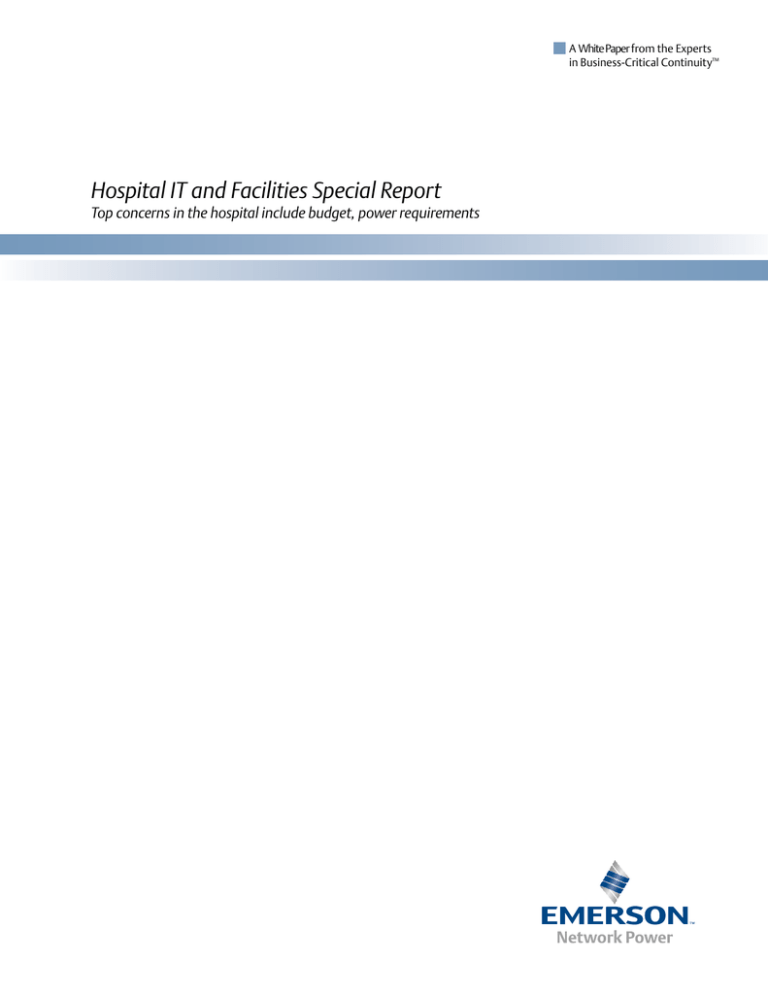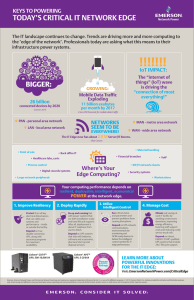
A White Paper from the Experts
in Business-Critical Continuity™
Hospital IT and Facilities Special Report
Top concerns in the hospital include budget, power requirements
Executive Summary
Budget and power requirements were listed as the top IT-related concerns inside the
hospital, according to a mid-year 2010 survey of IT managers, facility managers, data center
managers and engineers. Given the mission-critical nature of healthcare IT, the audience
pointed to system availability as the next highest priority inside the hospital. Other notable
results from the survey included:
More than one-half of hospitals needed to upgrade their power and cooling infrastructure
when implementing new technologies like Voice over Internet Protocol (VoIP)/network
communications (58 percent) and picture archiving and communication systems (PACS)
(54 percent), indicating a correlation between the importance of power and cooling
infrastructure and the reliance on IT systems.
Although 75 percent of hospital data centers supply power through a centralized
uninterruptible power supply (UPS) system, more than one-half of network closets are
supported by small, individual UPS systems rather than a large, facility-wide unit. This
discrepancy highlights the lack of understanding regarding the benefits of a centralized
UPS system to maintain multiple network closets in the hospital setting.
Inside the hospital, where IT usage comes to the point of care, more than one-half of
patient rooms are not supported by any uninterruptible power source. Additionally, just
28 percent of operating rooms have all emergency power receptacles serviced through a
UPS. This lack of protection makes point-of-care technologies vulnerable to downtime.
Despite the recession, 60 percent of respondents are planning to add more server and
storage capacity in their hospital data centers in the next 24 months. More than one-half
are planning to update or expand IT infrastructure within an existing hospital. Twentyseven percent plan to expand the existing hospital, while 15 percent plan to build a new
facility.
Thirty-two percent of those surveyed had experienced unplanned downtime of their IT
systems, while 29 percent responded that their data centers did not deploy redundant
power systems or didn’t know what type of distribution strategy was being used.
This suggests that, despite an increased reliance on IT, there is a lagging awareness of
infrastructure technologies and strategies.
Those responsible for IT-related issues inside the hospital continue to face the challenge of
balancing fluctuating budgets and growing power requirements with a constant need for
availability. Although most hospitals have already implemented technologies like electronic
medical records (EMRs) and VoIP, the survey indicated that a number of facilities have not
taken full advantage of infrastructure upgrades to ensure the applications continue to
operate uninterrupted. As the dependency on availability, particularly inside the hospital,
continues to rise, IT and data center managers will seek additional options to balance their
needs.
2
Survey Methodology
Nearly one-half of the respondents come
from a self-identified Tier III (multiple
independent distribution paths serving
dual powered IT equipment) or above
organization, and 65 percent had primary
data centers comprising less than 5,000
square feet. Figures 1 and 2 show specific
breakdowns.
Respondents to the survey fill a variety of ITrelated roles inside the hospital. Nearly onehalf (47 percent) were in IT management/
IT operations, 15 percent were in data
center management and 11 percent were
in facilities management. Twenty percent
of the respondents were facility engineers.
Data Center Tier
Data Center Tier
Tier I – Single non-redundant electrical
distribution path serving the IT equipment
16%
Tier II – Single distribution path with redundant
power and cooling infrastructure components
22%
Tier III – Multiple independent distribution paths
serving dual powered IT equipment
38%
Tier IV – Multiple independent distribution paths
fed from separate utility sources serving
dual powered IT equipment
11%
Don’t know
13%
0%
5%
10%
15%
20%
25%
30%
35% 40%
50%
Figure 1: Respondents represented data centers ranging from Tier I to Tier IV.
Data
Data Center
SizeCenter Size
9%
Less than 500 sq ft
36%
500-2,500 sq ft
20%
2,501-5,000 sq ft
15%
5,001-10,000 sq ft
5%
10,001-25,000 sq ft
7%
25,001-50,000 sq ft
Greater than 50,000 sq ft
2%
5%
Don’t know
0%
5%
10%
15%
20%
25%
30%
35%
Figure 2: Respondents represented data centers ranging in size from less than 500
square feet to more than 50,000 square feet.
3
40%
This hospital-specific survey corresponded
both with the highly publicized healthcare
reform legislation at the federal level
and ongoing discussions regarding
digitizing healthcare records and satisfying
meaningful use for stimulus funding. At
the time of the survey, the economy was
starting to show signs of recovery, giving
the healthcare industry some stability and
room to grow.
file storage and performance creates a
corresponding need to have greater control
over the IT infrastructure in order to assure
the continuous operation of technology
systems. Without disturbance-free power
support provided through a UPS, any outage
or voltage sag could limit access to vital
patient data or other equipment. Proper
environmental control – temperature,
humidity and air quality – also is needed to
keep sensitive electronic equipment at safe
operating temperatures, maintaining overall
system reliability.
Technology Inside the Hospital
The desire to improve patient care, as well
as factors such as federal government
initiatives and physician attraction and
retention strategies, continue to drive
the deployment of new technologies
throughout the hospital. The technologies
implemented throughout today’s hospitals
include wireless IT, PACS, VoIP and EMRs.
According to the survey, more than one-half
of hospitals needed to upgrade power and
cooling infrastructure when implementing
VoIP/network communications and PACS
(See Figure 3). Forty-nine percent of those
deploying EMRs also saw a need to upgrade.
The results indicate that the majority of
survey respondents realize the need to be
proactive in upgrading power and cooling
infrastructure at the time of technology
deployment, rather than waiting for
problems to occur. Delaying infrastructure
upgrades can result in problems including
damage to expensive equipment; loss of
patient data and/or corrupted diagnostic
images; and revenue loss due to patient/
staff dissatisfaction.
Although healthcare often is behind other
industries in adopting new technologies,
hospitals have moved quickly to deploy IP
telephony and wireless LANs to save money
and more effectively provide connectivity
in older buildings. EMR implementation
has helped to make workflows more
efficient, improve the quality of patient care
and reduce costs. The use of VoIP aligns
with the trend to unify and streamline
communications, and use of PACS offers
faster access to diagnostic information,
reduces the need for film and film storage,
virtually eliminates the problem of lost films,
and increases radiologist and physician
satisfaction and productivity.
Balancing Budget, Power and
Availability
Despite the economic recession, survey
respondents reported 2010 budget
increases of 6 percent on average. More
specifically, one-half of the respondents saw
an increase in their budgets, while one-third
faced budget cuts. See Figure 4 for specific
breakdowns.
As these new technologies are deployed
within the hospital, it is vital to consider
the power and cooling infrastructure
needed to support those applications. The
required increase in computing capacity,
4
Power and Cooling Upgrades When Implementing IT Projects
Electronic Medical
Records (EMR)
26%
Mobile Computing
IT Medical Carts
16%
24%
Picture Communication
Systems (PACS)
14%
9%
35%
0%
10%
61%
12%
37%
Wireless
Technology
51%
11% 4%
28%
VOIP / Network
Communications
7%
20%
47%
12%
42%
6% 6%
30%
40%
53%
50%
60%
70%
80%
90% 100%
Upgraded power & cooling at
time of implementation
Upgraded power & cooling
within year of implementation
Currently need to upgrade
power & cooling
Did not upgrade power & cooling
Figure 3: Respondents indicated when they upgraded power and cooling infrastructure
in conjunction with technology deployments inside the hospital.
2010 Budget Changes (Generalized)
26% or More
21% to 25%
16% to 20%
11% to 15%
6% to 10%
1% to 5%
0
-1% to -5%
-6% to -10%
-11% to - 15%
-16% or More
Not Sure
2%
4%
6%
4%
24%
20%
6%
6%
2%
4%
14%
0%
5%
10%
15%
20%
Figure 4: Respondents described the fluctuations to their 2010 IT budgets.
5
25%
While budget certainly is top-of-mind, the
evolution of the hospital into an always-on
technology center has driven the emerging
criticality of both power and availability
inside the facility and in the corresponding
data center. Technologies, such as EMRs
and digital imaging, have revolutionized
the healthcare industry by streamlining
processes, eliminating waste, improving
accuracy and, most importantly, improving
patient outcomes. As these systems become
seamlessly woven into the fabric of how
healthcare is delivered, however, their
continuous operation becomes increasingly
critical.
UPS system. Despite the decreased cost,
increased efficiency and availability benefits
of the centralized approach, more than
one-half (65 percent) of network closets and
imaging/radiology rooms inside the hospital
still use a decentralized/dedicated UPS
system.
Moving into the hospital, where IT availability
also is critical, 62 percent of respondents
reported their patient rooms do not have
a UPS at all (See Figure 5). Additionally, 42
percent of nurses’ stations and 20 percent
of operating rooms reportedly also lack
UPS protection. Having key areas within
the hospital without UPS protection makes
point-of-care technologies – such as access
to patient data – vulnerable to downtime.
For more information on best practices for
UPS deployment for life critical applications
in hospitals, see Emerson Network Power’s
white paper, Best Practices in Protecting the
Technology Systems Revolutionizing Healthcare,
available at www.liebert.com.
There are various approaches to power
supply and protection, although the
centralized UPS approach has been touted
for its cost-effectiveness and efficiency when
supporting large, mission-critical systems
such as those in the hospital. Rather than
implementing separate small UPS systems
at the device level—which can reduce power
system reliability and scalability, and also
increase costs and maintenance over time—
the centralized approach places a larger
UPS upstream of the power distribution,
providing protection for multiple devices
and receptacles. As compared to placing UPS
systems at the device level, the centralized
approach results in advantages including
improved efficiency (94 percent compared to
90 percent), greater reliability and scalability,
and a lower total cost of ownership. The
five-year TCO for a single 400 kVA unit is 26
percent less than for four, 100 kVA units. The
same cost benefits hold true for a single 80
kVA UPS compared to 10, 8 kVA units.
Although most survey respondents indicated
they had not experienced unplanned
downtime in the past year, the concept of
availability inside the hospital remains a
concern. Of those who had experienced
unplanned downtime, 18 percent said patient
needs were mildly impacted. Seven percent
noted significant patient and staff impact
as a result of unplanned downtime (See
Figure 6). Even brief power outages and/or
voltage sags can lead to a number of issues
inside the hospital, impacting the patient
both directly and indirectly. These events can
include corrupted diagnostic images, lost
time and revenue as patients and staff wait
for IT equipment to reboot (or as equipment,
such as an MRI machine, is unavailable), and
damage to expensive medical equipment.
Following the trend, 75 percent of the survey
respondents indicated their hospital data
centers supply power through a centralized
6
UPS Supply Methods
Data Center
75%
Network Closet
25%
33%
Nurse Station
65%
20%
Operating Rooms
38%
42%
29%
Imaging / Radiology
51%
20%
32%
Patient Rooms
58%
18%
0%
10%
2%
20%
20%
30%
10%
62%
40%
50%
Centralized / Facility-wide UPS
60%
70%
80%
Decentralized / Dedicated UPS
90%
100%
No UPS
Figure 5: Respondents identified their UPS power supply methods in different areas
of the hospital.
Occurrence of Unplanned Downtime
67%
Have not experienced unplanned downtime
Yes, users / patients were impacted mildly
(inconvenienced, but job functions could continue)
18%
Yes, users / patients were impacted significantly
(unable to perform job functions)
7%
Yes, but users / patients were not impacted
7%
Don’t know
0%
0%
10%
20%
30%
40%
50%
60%
70%
Figure 6: Respondents indicated the occurrence of unplanned downtime in their
hospitals over the past year, and how they were impacted as a result.
7
80%
Major Changes and Expansion Coming
operating without interruption in the event
of a total UPS failure. Although a large,
centralized UPS represents a higher first-cost
investment than multiple, small UPS systems,
the total cost of ownership is lower when
taking into consideration the cost to scale
and maintain multiple units. Additionally,
when building a new facility, managers are
well advised to plan for the space required to
house a large UPS.
Despite the recession, major changes and
expansion are on the horizon for hospitals
(See Figure 7). In the next 24 months, 60
percent of survey respondents indicated they
plan to add more server and storage capacity
in their hospital data centers. More than
one-half are planning to update or expand
IT infrastructure within an existing hospital.
Twenty-seven percent plan to expand the
existing hospital, while 15 percent plan to
build a new facility.
Inside the data center, where expansion
is needed due to increasing server
densities, cooling system scalability can be
accomplished via supplemental refrigerantbased systems. Precision cooling systems,
such as the Liebert XD, can bring cooling
closer to the source of heat, both in new-build
and retrofit situations. This allows cooling
to be focused where it is needed most and
can be added to, rather than displace, the
existing cooling system. For both new-build
IT facilities and expansions, designing highdensity architecture from the start results in
higher efficiency and lower operating costs.
When hospitals are building new facilities
or retrofitting existing facilities to
accommodate additional server and storage
capacity, managers may choose between
several different approaches to updating the
power infrastructure of the hospital.
For new facilities, it is ideal to implement
a centralized UPS configuration to supply
uninterruptible power to all critical areas
of the hospital. This approach enables
all downstream equipment to continue
Major Hospital Changes
Add more server and storage capacity in the data center
60%
Update / Expand IT infrastructure within existing hospital
51%
27%
Expand hospital
Consolidate existing data center
20%
Build new hospital
15%
Physically expand / build out current data center
9%
No changes
9%
Don’t know
9%
Other, please specify
9%
0%
10%
20%
30%
40%
50%
60%
70%
Figure 7: Respondents described the major changes they are planning to their hospitals
in the next 24 months.
8
Cloud computing
respondents mentioned this concern, likely
due to the sensitive nature of a hospital’s
business. Health Insurance Portability and
Accountability Act (HIPAA) regulations
make the protection of electronic patient
information absolutely vital. With the
increase in implementation of EMRs
inside the hospital, there is a coinciding
dependency on high availability. There are
risks involved with moving any application
into the cloud environment, and healthcare
enterprises are less willing than many other
organizations to take that risk.
Another area of change coming to
healthcare IT is cloud computing. The
survey identified several application services
which are currently being evaluated for
moving into cloud environments, whether
internal or external clouds. Web servers and
Web-based applications have the second
highest cloud adoption rate at 49 percent
(13 percent is specified as internal cloud).
Fifty percent plan to implement disaster
recovery/backup-as-a-service on an internal
or external cloud (See Figure 8).
The biggest concern cited by respondents
with regard to cloud computing was
security (See Figure 9). Forty-nine percent of
Implemented Cloud Computing Technologies
Databases
79%
21%
Email
37%
Infrastructure servers (i.e. file)
63%
30%
Enterprise applications (i.e. ERP)
70%
27%
Web servers and Web-based
73%
49%
Disaster Recovery / Backup
51%
50%
50%
Software Platform-as-a-Service
25%
75%
Hosting-as-a-Service
24%
76%
18%
Storage-as-a-Service
0%
10%
82%
20%
30%
40%
50%
60%
70%
80%
90% 100%
Figure 8: Respondents identified services currently being evaluated for moving into
cloud environments, either internal or external clouds.
9
Cloud Computing Concerns
Security
49%
33%
Performance
31%
29%
27%
Unforeseen costs
No concerns with cloud computing
Vendor reliability
22%
20%
Transparency / loss of direct control
Vendor / service lock-in
9%
Other, please specify
0%
10%
20%
30%
40%
50%
60%
Figure 9: Respondents identified their concerns with regard to cloud computing inside
the hospital.
10
Conclusion
This mid-year 2010 survey found that budget, power requirements and availability were
three top-of-mind issues for IT managers, facility managers, data center managers and
engineers working inside the hospital. In addition, these notable results emerged:
More than one-half of hospitals needed to upgrade their power and cooling infrastructure
when implementing new technologies like VoIP and PACS, indicating a correlation
between the importance of power and cooling infrastructure and the reliance on IT
systems.
Although 75 percent of hospital data centers supply power through a centralized UPS
system, more than one-half of network closets are supported by small, individual UPS
systems rather than a large, facility-wide unit. This discrepancy highlights the lack of
understanding regarding the benefits of a centralized UPS system to maintain multiple
network closets in the hospital setting.
Inside the hospital, where IT usage comes to the point of care, more than one-half of
patient rooms are not supported by any uninterruptible power source. Additionally, just
28 percent of operating rooms have all emergency power receptacles serviced through a
UPS. This lack of protection makes point-of-care technologies vulnerable to downtime.
Despite the recession, 60 percent of respondents are planning to add more server and
storage capacity in their hospital data centers in the next 24 months. More than one-half
are planning to update or expand IT infrastructure within an existing hospital. Twentyseven percent plan to expand the existing hospital, while 15 percent plan to build a new
facility.
Thirty-two percent of those surveyed had experienced unplanned downtime of their IT
systems while 29 percent responded that their data centers did not deploy redundant
power systems or didn’t know what type of distribution strategy was being used. This
suggests that, despite an increased reliance on IT, there is a need for increasing awareness
of infrastructure technologies and strategies.
11
Emerson Network Power
1050 Dearborn Drive
P.O. Box 29186
Columbus, Ohio 43229
800.877.9222 (U.S. & Canada Only)
614.888.0246 (Outside U.S.)
Fax: 614.841.6022
EmersonNetworkPower.com
Liebert.com
While every precaution has been taken to ensure accuracy and
completeness in this literature, Liebert Corporation assumes no
responsibility, and disclaims all liability for damages resulting
from use of this information or for any errors or omissions.
© 2010 Liebert Corporation. All rights reserved throughout
the world. Specifications subject to change without notice.
All names referred to are trademarks or registered trademarks
of their respective owners.
®Liebert and the Liebert logo are registered trademarks of the
Liebert Corporation. Business-Critical Continuity, Emerson Network
Power and the Emerson Network Power logo are trademarks and
service marks of Emerson Electric Co. ©2010 Emerson Electric Co.
SL-24650 (R09-10)
Emerson Network Power.
The global leader in enabling Business-Critical Continuity™.
AC Power
Connectivity
DC Power
Embedded Computing
Embedded Power
Infrastructure Management & Monitoring
Printed in USA
EmersonNetworkPower. com
Outside Plant
Power Switching & Controls
Precision Cooling
Racks & Integrated Cabinets
Services
Surge Protection



